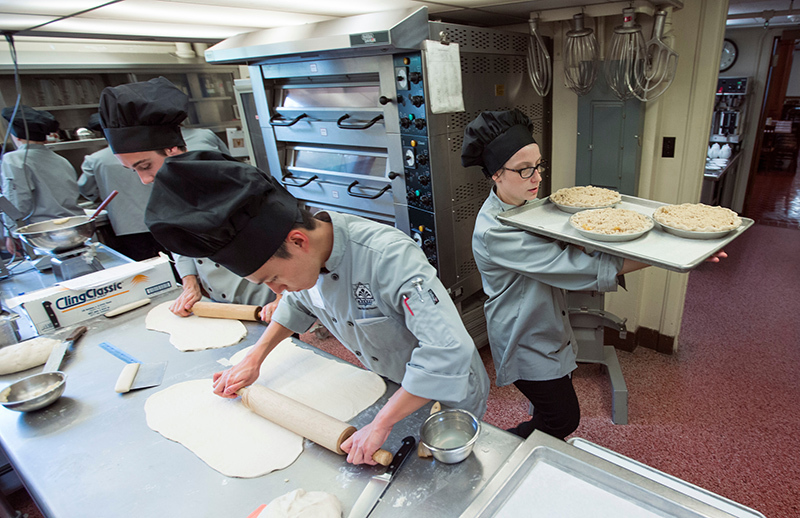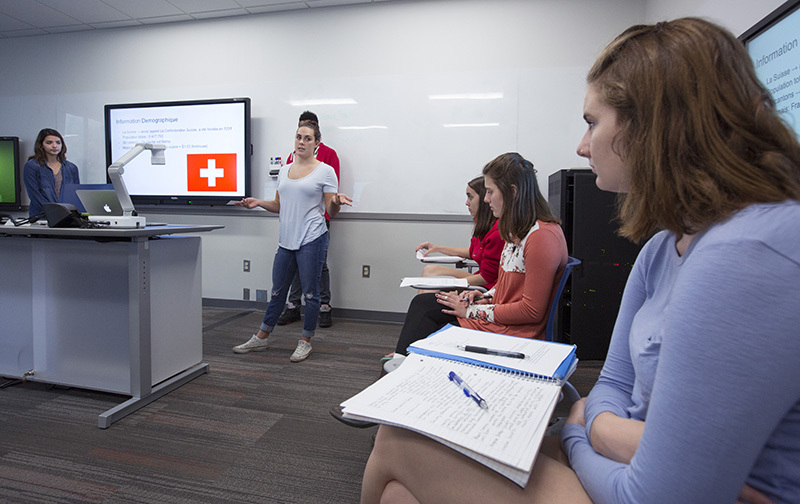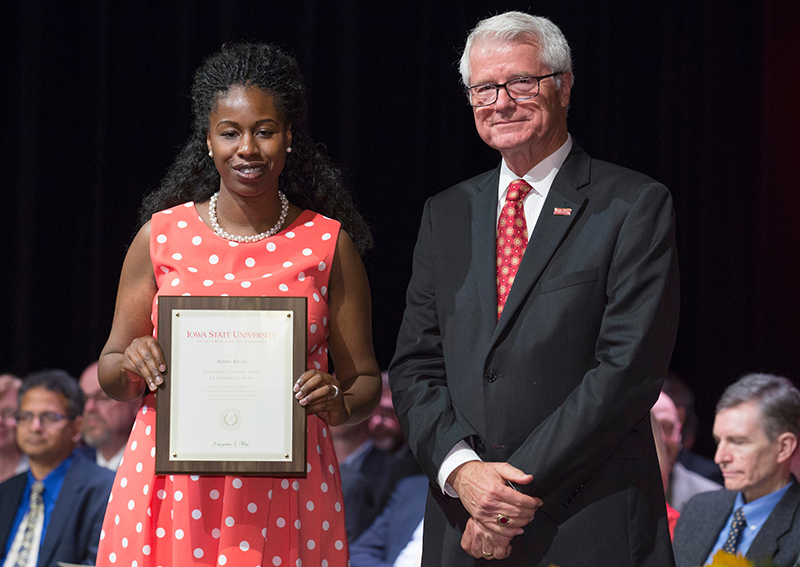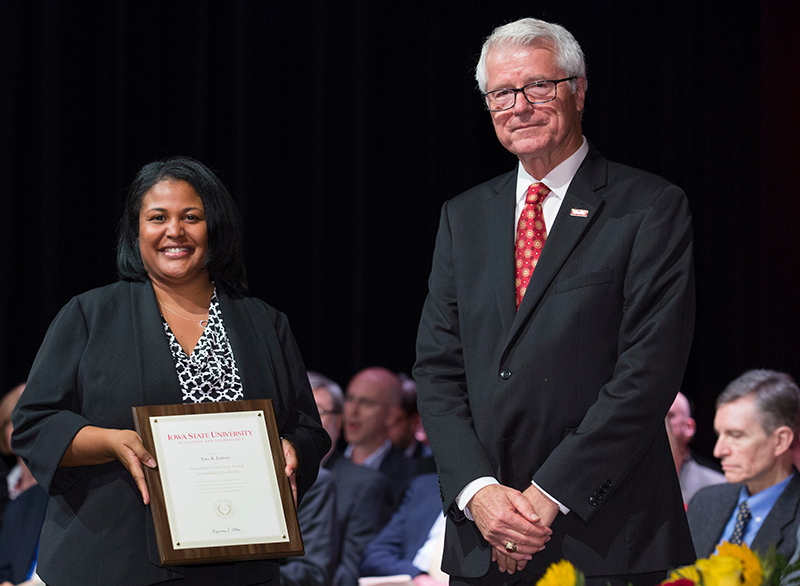Kitchen classroom

Photo by Christopher Gannon.
Kaiser Chen (center) rolls out dough for garlic bread and Michaela Corkery (right) moves pies for safe keeping as students prepared for another lunch audience last week in the Joan Bice Underwood Tearoom, lower level of MacKay Hall. The Tearoom's lunch program is the classroom teaching operation of Quantity Food Production and Service Management, a 300-level class in the hospitality management program. Over the course of the semester, students experience both "back of the house" and "front of the house" responsibilities in food service. Lunch is served to up to 100 guests four days a week (Tuesday-Friday); menus are posted online two weeks out.
Four presidential finalists invited to campus
Four people will have an opportunity to interview on Iowa State's campus to be the university's top leader.
After two days of interviews and meetings at a hotel in the Minneapolis area, the search committee charged with assessing Iowa State presidential hopefuls selected four finalists Wednesday, Sept. 27.
The candidates will be invited to visit Iowa State for further interviews and meetings, including an open forum. Those visits will be held Oct. 5-6 and Oct. 9-10.
The finalists' identities will be revealed one at a time 24 hours before each arrives. Details on when and where the forums will be held are being finalized and will be released later this week or early next week. An online form for feedback will be available on the university's presidential search website.
Finalists' names will remain confidential if they opt to withdraw from the search and decline to interview on campus.
Committee co-chair Dan Houston, chairman, president and CEO of Principal Financial Group, praised the quality of the four finalists.
"I thought we got to a good place," he said.
The process
The 21-member search committee spent all day Tuesday and Wednesday morning privately interviewing seven semifinalists they selected earlier this month from a pool of 64 candidates. An eighth semifinalist withdrew before interviewing.
A list of 12 questions was prepared, each to be asked by the same committee member in every interview. After the 75-minute interviews, candidates met briefly in private with Houston and his co-chair -- College of Design dean Luis Rico-Gutierrez -- to confirm continued interest, ask personal questions or discuss scheduling.
At the start of the two-day process, Rico-Gutierrez told the committee the semifinalists had "all the right ingredients," making the interviews a crucial element of their deliberations.
"This is going to be a really important two days," he said. "Literally, you'll be making history."
In a special meeting set for Oct. 23 in Ames, the state Board of Regents will discuss the search with the committee in a closed session, interview finalists and select Iowa State's 16th president.
Former President Steven Leath left Iowa State to be president of Auburn University last spring. Interim President Ben Allen will lead the university until the new president is on the job in early 2018.
Related stories
- Eight to interview for Iowa State presidency, Sept. 14, 2017
- More than 60 applicants considered in presidential search, Sept. 7, 2017
- Presidential search shifts to next phase, Aug. 24, 2017
- Search is on for Iowa State's next president, July 6, 2017
- Iowa Staters talk about their next president, June 15, 2017
- Presidential search timeline will match 2011 search, April 27, 2017
- Presidential search will be open, March 30, 2017
- Leath takes top job at Auburn University, March 23, 2017
Searches launch for Vet Med dean, Extension and Outreach VP
Senior vice president and provost Jonathan Wickert has launched searches for the next dean of the College of Veterinary Medicine and vice president of ISU Extension and Outreach.
Both units have interim leaders, Pat Halbur in Veterinary Medicine and John Lawrence in extension and outreach, who will serve until the permanent leaders are on the job, likely in summer 2018.
The startup of the searches has been timed so that Iowa State's next president, once named, will participate in the interviews and hiring decisions.
The searches will begin with the nomination of candidates and development of diverse candidate pools. Off-campus interviews are scheduled for January-February 2018, with on-campus interviews in February-March.
Veterinary Medicine dean
Beate Schmittmann, dean of the College of Liberal Arts and Sciences, and Ann Marie VanDerZanden, associate provost for academic programs, will co-chair the search for the next dean of Veterinary Medicine. Parker Executive Search will assist the committee. Joining Schmittmann and VanDerZanden on the search committee are:
University members
- Karin Allenspach-Jorn, veterinary clinical services
- Amanda Fales-Williams, veterinary pathology
- Deanna Gerber, Vet Med student recruitment office
- Tom Johnson, Lloyd Veterinary Medical Center
- Anumantha Kanthasamy, biomedical sciences
- Michael Kimber, biomedical sciences
- Alejandro Ramirez, interim assistant dean
- Jim Roth, veterinary microbiology and preventive medicine
- Holly Salzbrenner, student chapter of the American Veterinary Medical Association
- Jennifer Schleining, veterinary diagnostic and production animal medicine
External members
- Randy Ackman, Iowa Veterinary Medical Association
- Marv Johnson, Dean’s advisory council
- Marcus Kehrli, USDA/ARS National Animal Disease Center
- Clayton Kelling, University of Nebraska, Lincoln
- Greg Lear, Iowa Livestock Health Advisory Council
- Sue Robinson, Iowa Veterinary Specialties
- Kylee Thomas, Iowa Veterinary Medical Association
Extension and Outreach VP
Laura Jolly, dean of the College of Human Sciences, and Sarah Nusser, vice president for research, will co-chair the search for the next vice president of extension and outreach. Greenwood/Asher and Associates will assist the committee. Joining Jolly and Nusser on the search committee are:
University members
- Lisa Bates, extension community and economic development, Ames
- Jennifer Bentley, extension agriculture and natural resources, Winneshiek county
- Matt Helmers, agricultural and biosystems engineering
- Himar Hernandez, extension community and economic development, Wapello county
- Chad Higgins, extension central administration
- Andrea Nelson, extension Region 13
- Kevin Schalinske, food science and human nutrition
- Angela Shaw, food science and human nutrition
- Cayla Taylor, extension 4-H youth development, Ames
- Barbara Woods, extension human sciences, Ames
External members
- Mary Greiman, Iowa Beef Foundation and Region 2 County Extension Council
- John Harms, Iowa State Fair Board
- Craig Hill, Iowa Farm Bureau Federation
- Bob Petrzelka, Council for Agricultural Research, Extension and Teaching
Flexibility is focus in cutting-edge classrooms

Stacey Weber-Fève instructs her French 304 class in Pearson Hall 2125, a newly renovated classroom that opened this fall. It has movable chairs and multiple supplemental monitors meant to support team-based learning. Photo by Christopher Gannon.
Classrooms have changed a lot over the years, especially in how much they can change.
Iowa State experts involved in creating the university's newest learning spaces say flexibility is one of the top trends in modern classroom design, a capability that makes it easier to use active and team-based teaching styles to engage students.
"If we're going to ask faculty to do this, we need the space that will support it," said Ann Marie VanDerZanden, associate provost for academic programs and former director of the Center for Excellence in Learning and Teaching (CELT).
That means chairs and tables move easily, allowing students to form small groups even in lecture halls. Walls flanked with monitors, projection screens and white boards create more front-row seats and opportunities for teamwork and sharing. Teaching may extend beyond a room's walls, with monitors and tables in hallways for instructors to answer student questions after class without holding up the room.
Those innovations -- and other features common in new classrooms -- are informed by nationally recognized best practices and a unique focus on incorporating faculty input.
Finding feedback
Until just a few years ago, it was unusual for Iowa State faculty to have much say in general classroom renovations, said Katie Baumgarn, coordinator of instructional facilities for facilities planning and management.
Increased faculty involvement in design was recommended by a classroom improvement study in 2014, a report that also prompted an ongoing 10-year initiative to renovate the university's 210 general-use classrooms -- spaces not managed by departments or colleges.
"It's exciting to sit around the table with them and have them really share with us," Baumgarn said. "At first when I started working with faculty, they'd look at me like, 'What am I supposed to say because it's not going to happen.'"
Though budget constraints don't allow every idea to be implemented, faculty input helps tailor rooms for how they'll be used.
For instance, in classrooms in the new Bessey Hall addition, projection screens were installed instead of monitors to facilitate large photos shown in biology classes, Baumgarn said. In an upcoming renovation in Heady Hall, she said, a new style of white board that doubles as a projection screen is being considered because it's perfect for highlighting material in spreadsheets.
"When classes are in the right room, it can be a beautiful thing," Baumgarn said.
A natural feel
The new Pearson Hall classroom where Stacey Weber-Fève teaches French 304, a cultural study of French business environments, matches well with her focus on small-group learning -- students interacting and being accountable for their own education.
In Pearson 2125, the 32-seat room's three supplemental monitors have made breakout sessions more natural, she said. When assigned group work, her students intuitively cluster around the monitors without being instructed.
"It added an authentic element that I'd never experienced in a more traditional classroom," she said. "It was a cool feeling to experience that."
Having students huddled closely around monitors also expands what materials Weber-Fève can display during group work, allowing the use of more visuals because they're physically close enough to images to examine them.
Her students have been so much more enthusiastic that the conversational volume, plus the multiple monitors, has been overstimulating for Weber-Fève, at times.
"But they don't seem to be phased by it all," she said.

Student Danica Delaquis (standing, at center) leads a group discussion in her French 304 class in Pearson Hall 2125. Photo By Christopher Gannon.
Lecture learning
CELT has had a seat at the table in classroom upgrades, beginning with targeted remodels a few years ago in MacKay and Gilman halls and most recently in eight new Pearson classrooms and two in Hamilton Hall that opened this fall.
"As we've talked to colleagues at other teaching centers, very seldom do they get that opportunity to be part of that planning phase," VanDerZanden said.
It's a big reason why new classrooms aid active learning. For undergraduates, that style of teaching is familiar to their K-12 experience, said Laura Bestler, a CELT program coordinator involved in classroom renovations.
"If you take those students and plop them into a lecture hall space where they can't interact with other students, it may not be conducive to their learning," she said.
Heather Bolles, a senior lecturer in mathematics, has seen evidence of that in her own classroom. In a 153-seat auditorium in Sukup Hall, she teaches a team-based introductory calculus course that has improved student outcomes.
Like many other new lecture halls, every other row of fixed seats swivels around, allowing students to collaborate easier. Without swiveling seats, it would be difficult to organize teams of more than just a couple students, she said. Bolles also appreciates the spacing between seats, which is wider than in similar, older rooms.
"There's room for instructors to circulate," she said.
Driven by teaching
Flexibility isn't the only hallmark of a modern classroom. Responding to student feedback, extra electrical outlets and larger writing surfaces are added. Chairs are designed to be more comfortable. Natural lighting is used whenever possible. Sightlines and acoustics are important. CELT uses a national survey, the Learning Space Rating System, as a framework to guide some of those considerations.
Making technology easy and consistent is another emphasis, making tasks like dimming lights, connecting laptops and operating document cameras as simple as possible.
"Faculty won't want to deal with it if it's not easy and takes away from their time teaching the class," VanDerZanden said.
While those improvements are typical in any new learning space, not every classroom needs to have movable seating and multiple monitors. Some of Iowa State's best teaching faculty are traditional lecturers, Bestler said.
"It all depends on how they lecture and how they captivate the students," she said.
The approach to new classrooms hasn't been uniform for that very reason, VanDerZanden said. The point is to match faculty with spaces that work best for them.
"The decisions haven't been driven by the latest technology that we have to have in the space. It's driven by the teaching," she said.
Plans in place
There are many factors that determine which classrooms to overhaul. In general, the focus at first has been on underutilized small rooms in centrally located buildings, Baumgarn said. The university aims to have classrooms in use two-thirds of the time.
Financial considerations dictate the pace of classroom remodeling, and some of the same concepts could be used more broadly in teaching labs and other space controlled by departments, VanDerZanden said.
But the work done in the past few years on classroom design has positioned Iowa State to take maximum advantage of available opportunities, she said.
"We're always ready to say, 'This is what we know we need to do next,'" Bestler said.
Congratulations

Photos by Christopher Gannon.
(Pictured, above) Audrey Kennis, multicultural liaison officer in the College of Design, and assistant professor of human development and family studies Tera Jordan (photo below) are the inaugural recipients of the university's Award for Inclusive Excellence. Interim President Ben Allen presented the award during the university awards ceremony Sept. 25 in the Memorial Union Sun Room. The award recognizes faculty or professional and scientific staff who go beyond their usual job responsibilities to support the university's diversity, equity and inclusion mission. Fifty-four employees shared 29 university awards at this fall's event.

Allen outlines efficiency savings, regents approve state funding request
Iowa State units have saved more than $22.7 million in cost reductions or avoided future costs since 2014, interim President Ben Allen told the state Board of Regents during a special meeting Sept. 25.
The board faces an Oct. 1 deadline to submit its funding requests to the governor and Legislature for the fiscal year that begins next July 1. As part of that process and on the heels of more than $30 million in state funding cuts to the three regent universities from last year to this year -- and the need to reverse those cuts -- the regents asked the schools to compile data on their efficiency and cost-saving achievements.
Noting he wasn't presenting a comprehensive list, Allen said it would give board members "an appreciation for just how seriously we've taken the charge to operate more efficiently," particularly since 2014, when the board's TIER (Transparent Inclusive Efficiency Review) initiative launched.
"Efficiency is part of our culture at Iowa State," he said.
ISU cost reductions and avoided costs since FY14
|
Category |
One-time |
Recurring |
Total |
|
Salary/benefits |
$17,350 |
$6,143,114 |
$6,160,464 |
|
Operations* |
$2,750,628 |
$12,807,981 |
$15,558,609 |
|
Facilities |
-- |
$984,600 |
$984,600 |
|
Total |
$2,767,978 |
$19,935,695 |
$22,703,674 |
*Includes functions such as purchasing supplies, equipment and services; professional development;, printing, travel; communications
Allen said he and senior leaders, along with their teams, identified more that 115 projects that either reduced costs or, by their implementation, allowed the university to avoid anticipated costs. Examples among the three categories included:
Salary and benefits
- College of Design reorganization to centralize leadership and administrative support, $340,000
- Colleges of Liberal Arts and Sciences and Engineering joint venture in online education, $114,000
- ISU Police adjusted staff schedules to avoid overtime pay, $50,000+
- Controlling employee health care costs. Lower than projected claims costs saved Iowa State $2.2 million in FY15 and an estimated $3.2 million in FY16
Operations
- More than half of the savings was achieved in purchasing, a major focus of TIER. For example, a renegotiated DELL contract saved $4.1 million over computer retail prices.
- Standardized phone services saves $160,000 annually
Facilities
- The university's cogeneration power plant and efficiency efforts in new and existing buildings reduces energy consumption each year
Allen noted that efficiency will remain a priority for Iowa State, particularly since a five-year tuition proposal includes annual internal reallocations totaling at least 2.25 percent of the general fund operating budget. In the fiscal year that begins next July 1, that target amounts to $16.2 million. He said he has begun discussions with campus shared governance groups to identify strategies for reaching the mark.
"We are committed to making tough decisions about what we should be doing, as well as what we should stop doing, and then reinvesting those savings into our academic mission," he said.
FY19 appropriations request
Without discussion, the board approved an appropriations request for next year that includes an additional $12 million; $5 million each for Iowa State and the University of Iowa, and $2 million for the University of Northern Iowa. The incremental funds would be designated for resident undergraduate financial aid. The state ranks last in the nation in state need-based aid awarded to public university students.
The regents' FY19 request remains flat for all appropriations designated to specific ISU units -- for example, the Veterinary Diagnostic Lab, research park, and Ag Experiment Station. The board is requesting an additional $3.2 million in tuition replacement funds system-wide. This is the mechanism by which the state reimburses the universities for payments made (from tuition revenue) on state bonds issued for campus building projects. The need for these dollars is lower than usual in the current year due to savings gained from previous refunding bond issuances with lower interest rates.
Admissions to debut recruiting engagement software
This fall, admissions staff will use Salesforce software, as part of their migration to the Workday enterprise system, to manage the undergraduate student recruitment campaign. Thousands of contacts are added and developed during a one-year recruitment process.
"The manner in which the university communicates with prospective students during the recruitment process greatly influences students' impressions of the university, their level of interest in the university, their evaluative process in determining if the university is a good fit for them and ultimately, their decision to attend," said Laura Doering, associate vice president for enrollment management and student success.
"Our goal is to improve the recruitment process by improving how we communicate with prospective students and their families -- providing them with the information they need, when they want it. We want to be supportive and helpful in the college decision process."
WorkCyte
More than marketing
The move to Salesforce gives admissions staff next-generation, cloud-based software to manage communication during the recruitment process. But it's more than just automated marketing emails. It's an information system that builds individual profiles for students, helping to eliminate redundancies, such as multiple phone calls or emails with the same message.
"The ability to tailor information for each individual is a critical improvement in communicating with prospective students," Doering said.
Salesforce features a web-based interface, reporting options, marketing campaigns, location-based recruitment information and searchable fields of information. The Graduate College already uses Salesforce recruitment with some departments.
Another Salesforce advantage is the ability to track prospective students through stages. Based on their level of interest in becoming a student at ISU, individuals are placed in specific stages within Salesforce. This allows recruiters to predict the needs of each student as they progress through the stages of interest.
"Ideally, we'll be able to anticipate what the next stage is for each student, and deliver both the appropriate and desired information needed and wanted at each stage in their decision-making process," Doering said.
Workday integration
Part of the decision to use Salesforce was driven by its compatibility with the Workday student information system that will be implemented as part of Iowa State's WorkCyte initiative. The information gathered during the recruitment and admissions process will be integrated into Workday.
October rollout
The Salesforce system is on track for implementation by the end of October to align with admissions' next recruitment campaign.
Concepts and benefits in the new system likely will be analyzed for possible use in student onboarding procedures. A task force was appointed earlier this year to study and recommend onboarding procedures that help make the transition to life and learning at Iowa State easier for students.
"Going forward, that is exactly what we are trying to do," Doering said.
ISU Theatre's opener ties in to Banned Books Week
In coordination with national Banned Books Week (Sept. 24-30), ISU Theatre kicks off its 2017-18 season this week with a locally infused production of "Out of the Fire: The Banned Books Monologues." A series of 15 monologues, including two written by Iowa State students, explore the topics of censorship and banned books from a variety of viewpoints, such as the author of a banned book, a library patron requesting a banned book, a book character who's been banned or a reader challenging a book's validity.
"What does it mean to have freedom of expression? What are the ramifications when that is taken away? It's a timely and relevant conversation to be having," said Amanda Petefish-Schrag, assistant professor of theater and director of the production.
Performances begin at 7:30 p.m. Fridays and Saturdays, Sept. 29-30 and Oct. 6-7. Sunday matinees on Oct. 1 and 8 begin at 2 p.m., all in Fisher Theater.
Petefish-Schrag said it's exciting -- and a bit unusual -- to perform a play so recent. Most of the monologues were written by playwrights from around the country for a festival at the Forward Theater in Madison, Wisconsin, in February 2015. ISU Theatre leaders received permission from the Madison group and used its original solicitation to recruit student writers last spring. Monologues by graduate students Mat Wymore and Emily Horner emerged from a competitive writing and review process.
Petefish-Schrag called a monologue "a soulful journey with a beginning, a middle and an end." Because they're not interacting with other actors, monologue actors especially have to connect with their audience.
For the student actors, "it's a pretty vulnerable spot to be in, but they have lots of wonderful opportunities to make it earnest, urgent, honest and truthful," she said.
Tickets are $18 ($16 for seniors, $11 for students) and available at the Stephens Auditorium ticket office, through Ticketmaster or at the door.
Related events
Petefish-Schrag said she wanted to collaborate with local libraries during the show's run because of the "vital role libraries play in access to information and ideas." ISU Theatre students held public rehearsals at Parks Library Tuesday and Wednesday afternoon this week. The library lobby currently features a display of the banned books referenced in these monologues. It will remain on display through the play's run.
The student playwrights and several monologue actors and production staff will participate in a panel discussion about banned books at the Ames Public Library on Tuesday, Oct. 3 (7-9 p.m., library auditorium, 515 Douglas Ave.). Wymore and Horner's monologues will be performed as part of this event.
